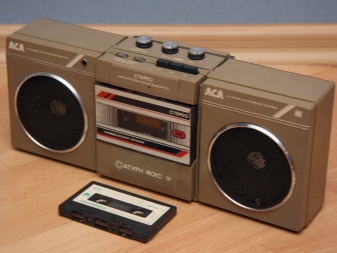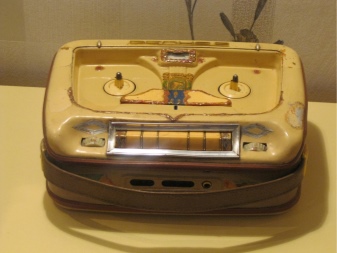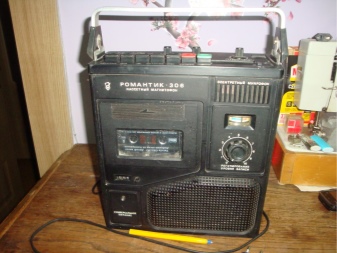USSR tape recorders: history and the best manufacturers

Tape recorders in the USSR are a whole different story. There are many original developments that still deserve admiration. Consider the best manufacturers as well as the most attractive tape recorders.


When did the first tape recorder appear?
The release of cassette tape recorders in the USSR began in 1969. And the first one was here model "Desna", produced at the Kharkov enterprise "Proton". However, it is worth giving credit to the previous stage - tape recorders playing reels of tape. It was on them that the engineers, who later created a number of excellent cassette versions, “stuffed their hand”. The first experiments with such a technique in our country began in the 1930s.
But these were developments purely for special applications. For obvious reasons, mass production was launched only a decade later, by the beginning of the 1950s. The production of bobbin technology continued into the 1960s and even into the 1970s.
Now such models are of interest mainly to fans of retro technology. This applies equally to both reel and cassette modifications.


List of the best manufacturers
Let's see which tape recorder manufacturers deserve increased public attention.
"Spring"
The tape recorders of this brand were produced from 1963 to the beginning of the 1990s. The Kiev enterprise used a transistor element base for its products. And it was "Vesna" that turned out to be the first device of its kind released on a wide scale. "Spring-2" was simultaneously produced in Zaporozhye. But it was also a reel to reel model.
The first bobbin-free apparatus appeared in the early 1970s. Its launch into production has long been hampered by problems with the industrialization of the brushless electric motor. Therefore, initially it was necessary to install traditional collector models. In 1977, the production of stereophonic devices was launched. They also tried to produce stationary tape recorders with stereo sound and radio tape recorders.
In the first case, they reached the stage of single prototypes, in the second - to a small batch.


"Gum"
This brand cannot be ignored either. It is she who owns the honor of releasing the country's first serial tape recorder on a cassette base. The model is believed to be copied from the 1964 Philips EL3300. This refers to the identity of the tape drive, overall layout and external design. However, it should be noted that the first sample had significant differences from the prototype in the electronic "stuffing".
Throughout the entire release, the tape drive mechanism remained almost unchanged. But in terms of design, there have been significant shifts. Some of the models (under different names and with minor changes) were no longer produced on Proton, but in Arzamas. The electroacoustic properties remained rather modest - there is no difference with the prototype in this.
The layout of the Desna family remained unchanged until the end of its release.

"Dnieper"
These are one of the oldest Soviet-made tape recorders. Their first samples began to be produced back in 1949. The end of the assembly of this series at the Kiev enterprise "Mayak" falls on 1970. An early version of "Dnepr" - the first domestic household tape recorder in general.
All devices of the family reproduce only coils and have a lamp element base.
The single-track "Dnepr-1" consumed a maximum of 140 W and produced a sound power of 3 W. This tape recorder can be called portable only conditionally - its weight was 29 kg. The design turned out to be poorly thought out from the point of view of ergonomics, and the parts of the tape drive mechanism were not made accurately enough. There were also a number of other significant drawbacks. The more successful "Dnepr-8" began to be produced in 1954, and the last model began to be assembled in 1967.


"Izh"
This is already a brand from the 80s. Collected such tape recorders at the Izhevsk motorcycle plant. The first models date back to 1982. In terms of the scheme, the initial sample is close to the earlier "Elektronika-302", but in terms of design there are obvious differences. The release of separate tape recorders and radio tape recorders "Izh" continued even after 1990.


"Note"
Audio equipment of a similar brand was put into production in Novosibirsk in 1966. The Novosibirsk Electromechanical Plant began with a tube coil model, which had a two-track design. The sound was monophonic only, and amplification was done through external amplifiers. The Nota-303 version was the last one in the entire tube line. It was designed for a relatively thin (37 μm) tape. A number of transistor versions were released in the 1970s and 1980s.

"Romantic"
Under this brand in the USSR, one of the first portable models based on a transistor base was released. According to the then generally accepted classification, the first "Romantics" belonged to class 3 tape recorders. Power supply from external rectifiers and from on-board networks of cars was structurally allowed. In the 1980s, the version "Romantic-306" enjoyed impressive popularity, which was appreciated for its increased reliability. Several developments were presented even at the turn of the most difficult 80-90s. The latest model is dated 1993.


"Gull"
The production of such reel-to-reel tube tape recorders was carried out by an enterprise in the city of Velikiye Luki. The demand for this technique was associated with its simplicity and low cost at the same time. The first model, produced since 1957 in a limited edition, is now represented only by rare items from collectors and retro fans. Then 3 more such modifications were released.
Since 1967, the Velikie Luki plant switched to the production of the Sonata series, and ceased to assemble the Seagulls.

"Electron-52D"
This is not a brand, but only one model, but it deserves to be included in the general list. The fact is that "Electron-52D" occupied, rather, the niche of the dictaphone, which was then almost empty. The design for the sake of miniaturization was simplified as much as possible, sacrificing the quality of the recording. As a result, it became possible to record only ordinary speech, and one could not count on the transfer of all the richness of complex sounds.
Due to the poor quality, lack of consumer habit of dictaphones and the very high price, demand was depressingly low, and Electrons soon disappeared from the scene.

"Jupiter"
Reel-to-reel tape recorders of 1 and 2 classes of complexity were produced under this name. These were stationary models developed by the Kiev Research Institute of Electromechanical Devices. "Jupiter-202-stereo" was assembled at the Kiev tape recorder plant. The monophonic version of Jupiter-1201 was made at the Omsk Electromechanical Plant. Model "201", which appeared in 1971, for the first time in the USSR had a vertical layout. The creation and release of new modifications continued until the mid-1990s.


Popular Soviet models
It is appropriate to start the review with the first top-class model in the USSR (at least, many experts think so). This is the version "Mayak-001 Stereo". The developers started from the trial product, "Jupiter", from the first half of the 1970s. Component parts were purchased abroad, and it was because of this that the Kiev manufacturer made no more than 1000 copies per year. With the help of the device, mono and stereo sound was saved, so were the playback capabilities.

It appears to be a truly excellent model that won the highest industry award in the world in 1974.
Exactly 10 years later, "Mayak-003 Stereo" appears, already producing a slightly larger spectrum of waves.And "Mayak-005 Stereo" was not at all lucky. This modification was collected in an amount of only 20 pieces. Then the company immediately switched from expensive to more budgetary devices.


"Olimp-004-Stereo" was deservedly one of the most popular devices at that time. They are distinguished by undoubted perfection. The development and production were jointly carried out by the Lepse plant in the city of Kirov, and the Fryazino enterprise.
Among the film models "Olimp-004-Stereo" produced practically the best sound. It is not without reason that people still speak positively about him to this day.

But among lovers of retro, a considerable part prefers lamp portable products. A striking example of this is "Sonata". Produced since 1967, the tape recorder is suitable for both playback and sound recording. The tape drive mechanism was borrowed without changes from "Chaika-66" - an earlier version from the same enterprise. The recording and playback levels are adjusted separately, you can overwrite a new recording over the old without overwriting.

It should be noted that small-scale tape recorders in the USSR were especially highly valued. After all, they were made almost by hand, and therefore the quality turned out to be higher than usual expectations. A good example of this - "Yauza 220 Stereo". Since 1984, the first Moscow electromechanical plant was engaged in the release of such a console.
Noteworthy:
- light indicators of key operating modes;
- the ability to control the recording by listening to it on the phone;
- the presence of a pause and hitchhiking;
- volume control of telephones;
- excellent noise reduction device;
- frequencies from 40 to 16000 Hz (depending on the type of tape used);
- weight 7 kg.
Separately, it should be said about the conventional signs used on audio equipment and radio devices. The circle with an arrow pointing to the right indicated line output. Accordingly, the circle from which the left arrow exits was used to denote a line inlet. The two circles, separated by an underscore, indicate the tape recorder itself (as part of other devices). The antenna input was marked with a white square, to the right of which the letter Y was located, and 2 circles next to it were stereo.

Continuing our review of iconic tape recorders from the past, MIZ-8 is also worth mentioning. Despite its cumbersomeness, it did not lag behind foreign counterparts. True, the rapid change in consumer tastes ruined this good model and did not allow it to reach its potential. Modification "Spring-2" proved to be, perhaps, more popular than other early portable devices. She was willingly used to listen to music on the street.


Radio cassette "Kazakhstan", which appeared in the 1980s, was good from a technical point of view. And there were quite a lot of people who wanted to buy it. However, the excessively high price prevented the realization of the potential. Those who could have become a devoted audience rarely afford such an expense. Also in the lists of once popular models you can find:
- "Vesnu-M-212 S-4";
- "Electronics-322";
- "Electronics-302";
- Ilet-102;
- "Olymp-005".


For an overview of the USSR tape recorders, see the following video.













Tell me what is the name of the tape recorder with two heads.
A tape recorder with a through channel recording: one head for playback, the second for recording.
The comment was sent successfully.